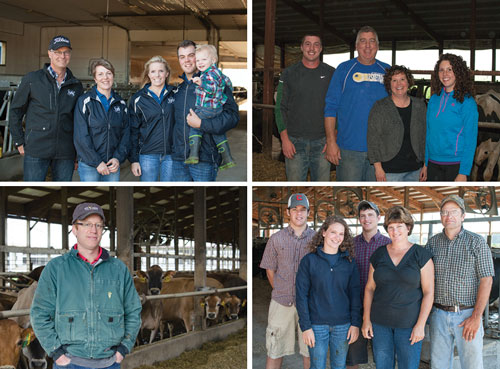
Coping with last year's extreme temperatures wasn't easy. In our December issue, we caught up with four dairy producers from among North America's coldest dairy regions to see how they kept their farms running as best they could.
The Brocks are from Michigan's Upper Peninsula; Crosbies, Canada's Prairie Provinces; Reynolds, western New York; and Temperli is from South Dakota. If you missed the December issue or currently are not a subscriber, send an email to hdcirc@hoards.com and we can get you that issue.
How did you keep water flowing? What about ice buildup?
Brock: We spent a great deal of time keeping waterers running in our cow barns. By February, we changed our strategy from keeping all the waterers running to keeping two-thirds of the waterers working. It was the best we could do. And we thought we were prepared for Upper Peninsula Michigan because we buried our water lines over 7 feet deep.
Our farm actually fared better than some of our homes as three houses owned by the farm had frozen water lines.
Crosbie: Despite the use of heat tape and heated/insulated water bowls, we still experienced issues with water bowls freezing up. We have yet to find a water bowl that won't freeze up in very adverse conditions. It's very important to monitor the water bowls at least once daily and we will get them running again as soon as we realize one has frozen up.
Our water lines are buried quite deep and we normally don't have issues with the lines freezing, although last year we had an issue with the water table getting too high and one line was frozen until June!
Ice buildup around the water bowls hasn't been an issue for us. In the main dairy barn, ice will build up down the sides of the water bowl but not on the ground and therefore doesn't present any traction issues. All of the heifer pens have dirt floors and ice buildup around the water bowls there hasn't presented any traction issues either.
Reynolds: We have electric heaters in our waterers. This wasn't a big problem for us.
Temperli: All our waterers are fed with lines underground so they never freeze. Our barns never get cold enough to build up any significant ice around the waterers. We have had an icy alleyway before which we took care of with salt.
When do you feel your herd finally began to recover from stress of this winter?
Brock: As we said earlier, first-calf heifers took a long time to recover.
Crosbie: I don't think winter puts a lot of stress on the herd, provided there is enough energy in their diet. However, when we expanded in 2012, we brought in some cows from warmer climates and it took them approximately a year to acclimate. They didn't grow the typical long winter hair coats during the cold months like the rest of the herd and that group seemed to suffer somewhat during the cold spells. The animals born here seem to be well-acclimated and will even be born with a thicker hair coat in the fall and winter months.
Reynolds: We felt that, overall, our animals handled the winter quite well.
Temperli: The young stock, given the facilities and adjusting up the energy of their diets, were not set back. We do raise the bypass fat levels in the lactating cows' diets early in winter so they never fall behind in repro or production.
Did you change milking procedures or teat dips?
Brock: We did not change milking procedures, but we did have multiple milker-team meetings to make sure that our prepping procedures were correct. We were assisted by our milk cooperative and veterinarian at these gatherings.
Crosbie: Milking procedures remain the same. We did change our postdip to one with more teat conditioners, since teats will become drier in the colder months. In regards to frozen or chapped teats, it can become a concern when the animal is exposed to drafts either right before or after calving and has edema present in the udder. We try to avoid that by moving them to our insulated barn sooner.
Reynolds: Prior to winter, we always boost the emollient levels in our teat dip. We also do not postdip if it is going to be extremely cold or windy. Last year, we did see a few teats that got frostbite. That was a highly unusual experience.
Temperli: We always foam our postdip except when temperatures get below -30°F with the wind chill outside. At that temperature, we switch to liquid dip instead of foaming. We use a 10 percent emollient dip in the winter to keep teat skin conditioned. We did not have any damaged teats due to the cold.








